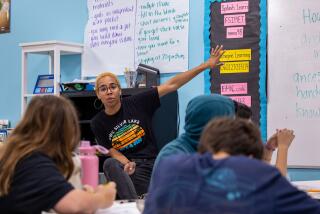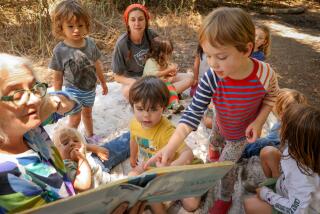Teachers’ Text a Lesson in and of Itself
This is a tale of reading, writing and rejection.
A few years ago, Fountain Valley grade school teacher Leigh Hoven-Severson decided to gather a few colleagues together and tackle a daunting task--writing a science textbook.
After toiling on their own time, the teachers submitted their finished product--a series of books for kindergarten through fourth grade dubbed Exploring Science--to the state of California’s science textbook selection committee.
Hoven-Severson and her co-authors figured they had a winning recipe, educational guidebooks full of stimulating experiments and lesson plans to fan the critical thinking skills of young students.
But the state textbook selection committee didn’t share that view. The panel tossed aside the humble-looking texts, delivering a blistering review that reduced Hoven-Severson to tears. Rejected from the A-list, Exploring Science was ineligible for most of the state money school districts around California rely heavily upon to buy textbooks. For a small scholastic publisher, that can be a mortal blow.
Battered but not beaten, Hoven-Severson and company tried a different tack, marketing their books on the Internet, pushing them into a national catalog of school science supplies and then haunting educational conferences to pitch the program.
Now, five years after the local teachers first set pen to page, they’re seeing a few signposts of success.
What California so thoroughly rejected, the state of Utah has welcomed on its list of recommended science texts. Apparently a schoolbook--like beauty--is in the eye of the beholder: The Utah review called Exploring Science “new, exciting.”
Hoven-Severson’s own classes at James H. Cox Elementary School are using the book anyway and have finished first in the state three years running in a NASA science education contest. One third-grade team, which finished second nationally in 1994, consisted of three students whose native languages were Hindi, Farsi and Chinese.
In Ohio, educators at a low-income district credit Exploring Science with helping students produce remarkable results on a state-administered test of proficiency. Classes that used the text are scoring higher in science than districts in wealthy surrounding communities.
“If you take a short look at their manual, you want to push it aside because it looks very black-and-white, it doesn’t have the frills and the fluff,” said Mary Linton, curriculum director at Struthers City School District in Ohio. “But it’s got the content, it’s got the meaning.”
State education officials in California defend their decision on Exploring Science, saying it and the other science texts submitted back in 1992 were judged fairly.
“It should be seen as nothing more or less than a point of view,” said Glen Thomas, state assistant superintendent for elementary education. “It doesn’t mean these materials shouldn’t be used in schools.”
Thomas also noted that school districts are given leeway to spend 30% of the state instructional material money they get on books of their own choice, including Exploring Science.
Even so, many districts stick to the state-approved list. The state’s OK on a textbook gives it marketing cachet not only in California, but in school districts across the nation.
“It helps a text sell well in other states because they know California has a pretty rigorous review,” Thomas said. “But ultimately a program rises or falls on its own merits.”
Others say the selection system favors big publishers from the get go.
Maureen DiMarco, Gov. Pete Wilson’s education secretary and a critic of California’s method of choosing schoolbooks, said the selection panels “are full of bias.” And the big publishers are well known by state Education Department staffers, she said, giving them a leg up.
“It’s kind of like automobiles,” she said. “If the prevailing view is that Honda, Toyota and Nissan are the way to go, and you’re a new auto manufacturer, then you’re going to have a tough time cracking that attitude--even if you have a better vehicle.”
Although she has not read Exploring Science, DiMarco concluded that Hoven-Severson “confronted a well-constructed system that is not designed for innovators who are educational practitioners.”
None of that eases the pain for the Exploring Science team, which includes Cox Elementary teachers Kathleen Davis Manuel and Carrie Luger Slayback as well as the district’s special projects director, Linnea Nell Haley, and Harriette “Jerry” Bolliger, a 45-year veteran teacher who retired in 1992.
Hoven-Severson said the idea hatched one day in 1991 when she talked with her cousin, a school administrator in Kern County who had just returned from a conference brimming with excitement about the state’s newly crafted science text framework.
Why not give it a go? She had the seed money from an inheritance from her parents. Her husband, Larry, was willing to step aside from his job in the aerospace industry to act as day-to-day pitchman for the project.
They set up their own publishing house, called Macro Press Inc., and sat down to write. No one took salaries. Everyone worked long and hard after the final school bell.
The result is, if anything, a primer on how to make the best of a low budget.
For starters, the Exploring Science text is priced considerably less at $15 per pupil than those produced by big publishers, which can cost at least three or four times more.
And the book contains exercises that don’t require expensive microscopes, laboratory specimens or pricey Pentium computers. A typical experiment might involve a piece of bread that is weighed, studied and then toasted, only to be weighed and studied some more. The lesson? To demonstrate changes in density and allow students to hypothesize how and why it occurs.
“Part of what drove us to do this was idealism; part was naivete,” Hoven-Severson says now. “We really thought we could make a difference. We just had no idea what we were up against, and we had faith in a system we now believe is flawed.”
Of the more than two dozen publishers who submitted texts to the state for review, just eight were selected. Most are big scholastic publishing houses whose volumes feature glossy hard covers, computer software and other inviting bonuses. Of those rejected, the critique of Exploring Science was among the most brutal.
The review committee scalded Hoven-Severson’s text as containing “many errors of interpretation or fact.” One example they cite is the erroneous statement “a billion is a million millions”--it’s actually a thousand millions.
Reviewers said the text also doesn’t clearly explain why certain scientific concepts are important. Though hands-on learning is used at least 40% of the time, “children are often treated as passive learners,” the committee found. Moreover, they said, opportunities for “multicultural experiences” are missed.
Hoven-Severson couldn’t believe it.
“When we first started, we told them we couldn’t put this in a really polished form in the time we had left,” she said. “They said don’t worry. Then the reviewers dinged us for just the sorts of things they said they would roll with.”
For a time they tried to fight. The wrote rebuttals to the state Education Department. Former state Sen. Marian Bergeson, now an Orange County supervisor, tried to intercede on behalf of Macro Press, but to no avail. For a time, Hoven-Severson and her colleagues thought about suing. They dropped that notion after considering the costs and pitfalls of a drawn-out lawsuit.
The harsh summation Exploring Science drew from the California reviewers contrasts sharply with the findings of several teachers who have used the texts in other states in the years since.
Claud Greenlee, president of Science Teachers of Missouri and a science instructor in Russellville, Mo., said the program not only helps get pupils interested in science, it also tutors them all at once in math, reading, literature, history and social studies.
For instance, children learning about ecology are urged to write a poem. To remember what they’ve learned about the senses of eyesight and hearing and taste, children sing a song.
“I like the fact it has students making a paper airplane out of a rubber band and a discarded Kleenex box,” Greenlee said. “Reviewers look at that and say it isn’t sophisticated science because you’re using all this junk. But to me it’s creative. I’m sold on the program.”
Ruth Ann Davenport, a first-grade teacher in Wasatch, Utah, calls it “a good user-friendly program” for both student and teacher. She likes one hands-on experiment that proves buoyancy, using available objects like tinfoil and a hunk of wood.
“California is the loser for not accepting this as far as I’m concerned,” she said. “This program has been put together by teachers. They’re the best ones to do it--they’ve been down in the trenches. They know the difficulties you’ll face in the classroom.”
Hoven-Severson remains hopeful the texts she helped create will eventually find a place in more classrooms.
“I think maybe there’s a niche,” she said. “Perhaps we were ahead of our time. Maybe the time has come.”
More to Read
Sign up for Essential California
The most important California stories and recommendations in your inbox every morning.
You may occasionally receive promotional content from the Los Angeles Times.









